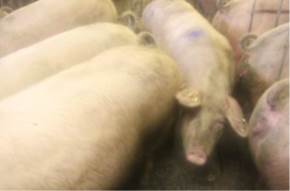Pen Layout

What To Look For:
Look at the pen usage by the pigs – are the dunging area, drinkers and feeders at or near one end of the pen, or are pigs having to cross the lying area to get between them? Are pigs in the lying area being disturbed by pigs trying to access the feeders?
Pigs habitually wake from resting, go to defecate, eat, drink then return to resting. If they have to walk through the resting area to do this, they are likely to disturb pigs that are trying to rest.
If the pigs are resting in the dunging area this suggests that the building or pen ventilation is not creating the best patterns of cool and warm air for the pigs.
Pen layouts where the lying area obstructs pigs moving between dunging area, feeders and drinkers, especially if pen shape is long and narrow, which can restrict pig movement further.
Additional information:
Look at the pen usage by the pigs – are the dunging area, drinkers and feeders at or near one end of the pen, or are pigs having to cross the lying area to get between them? Are pigs in the lying area being disturbed by pigs trying to access the feeders?
Pigs habitually wake from resting, go to defecate, eat, drink then return to resting. If they have to walk through the resting area to do this, they are likely to disturb pigs that are trying to rest.
If the pigs are resting in the dunging area this suggests that the building or pen ventilation is not creating the best patterns of cool and warm air for the pigs.
Pen layouts where the lying area obstructs pigs moving between dunging area, feeders and drinkers, especially if pen shape is long and narrow, which can restrict pig movement further.
Suggestions:
- Observe the pigs once settled in the pen in case they are not lying in the expected lying area and are ending up walking through resting animals
- The original design of the building should establish ventilation patterns which assist the pigs in distinguishing lying areas and dunging areas in the pens.
- Lying areas should be in the warmer area, dunging area in a cooler area (eg under incoming colder air)
- Drinkers should be near the dunging area (for drainage)
- Feeders shouldn’t be too close to the dunging area
- Avoid pen layouts where the lying area is in the centre of the pen, as this encourages pigs to walk across the lying area every time they get up to defecate, eat and drink.
- Where pens are small, or narrow, pen layout is even more important as there will be limited routes that the pigs can take when moving around the pen
- Where pigs are resting in the dunging area, look at how the ventilation of the building or pen can be managed so that the pigs are able to lie in a comfortable temperature in the lying area (usually this should be the warmer part of the pen) – see suggestions under Dunging in the Lying Area
Additional material:
Using pig behaviour to optimise pen design
http://www.thepigsite.com/articles/928/using-pig-behaviour-to-optimize-pen-design/
Information about ventilating pig buildings: https://ahdb.org.uk/knowledge-library/ventilating-pig-buildings
AHDB ventilating pig buildings guide http://pork.ahdb.org.uk/environment-buildings/pig-buildings-housing-development/ventilation/ventilating-pig-buildings-guide/
Gadd, J. (2003). Pig Production Problems: A Guide to their Solutions. Nottingham University Press.
